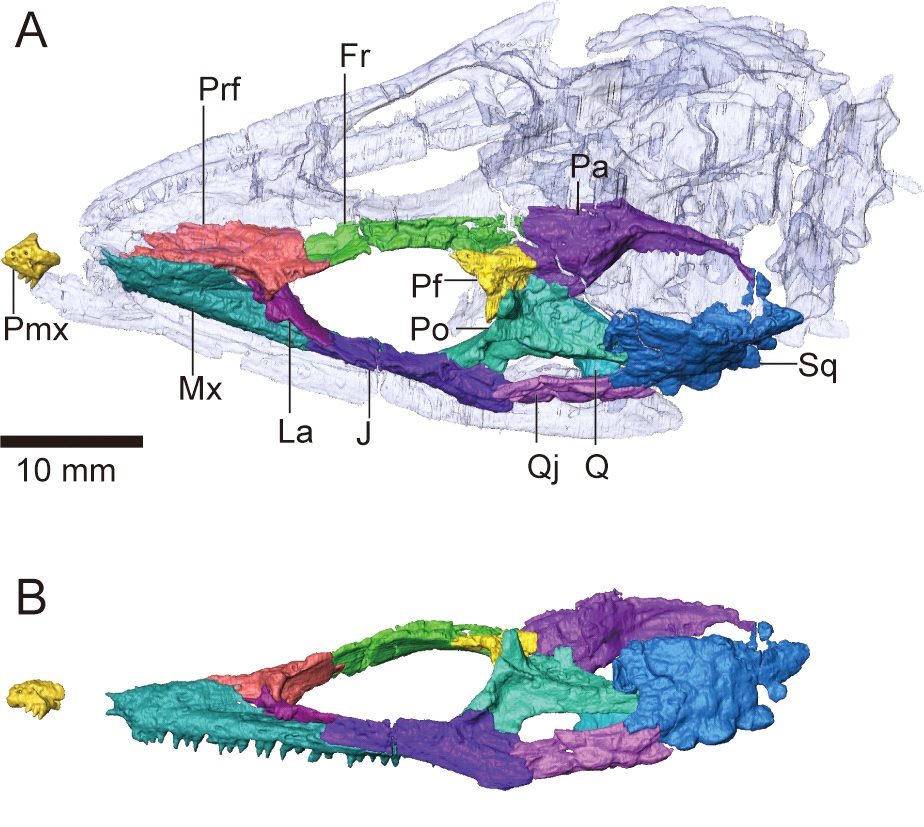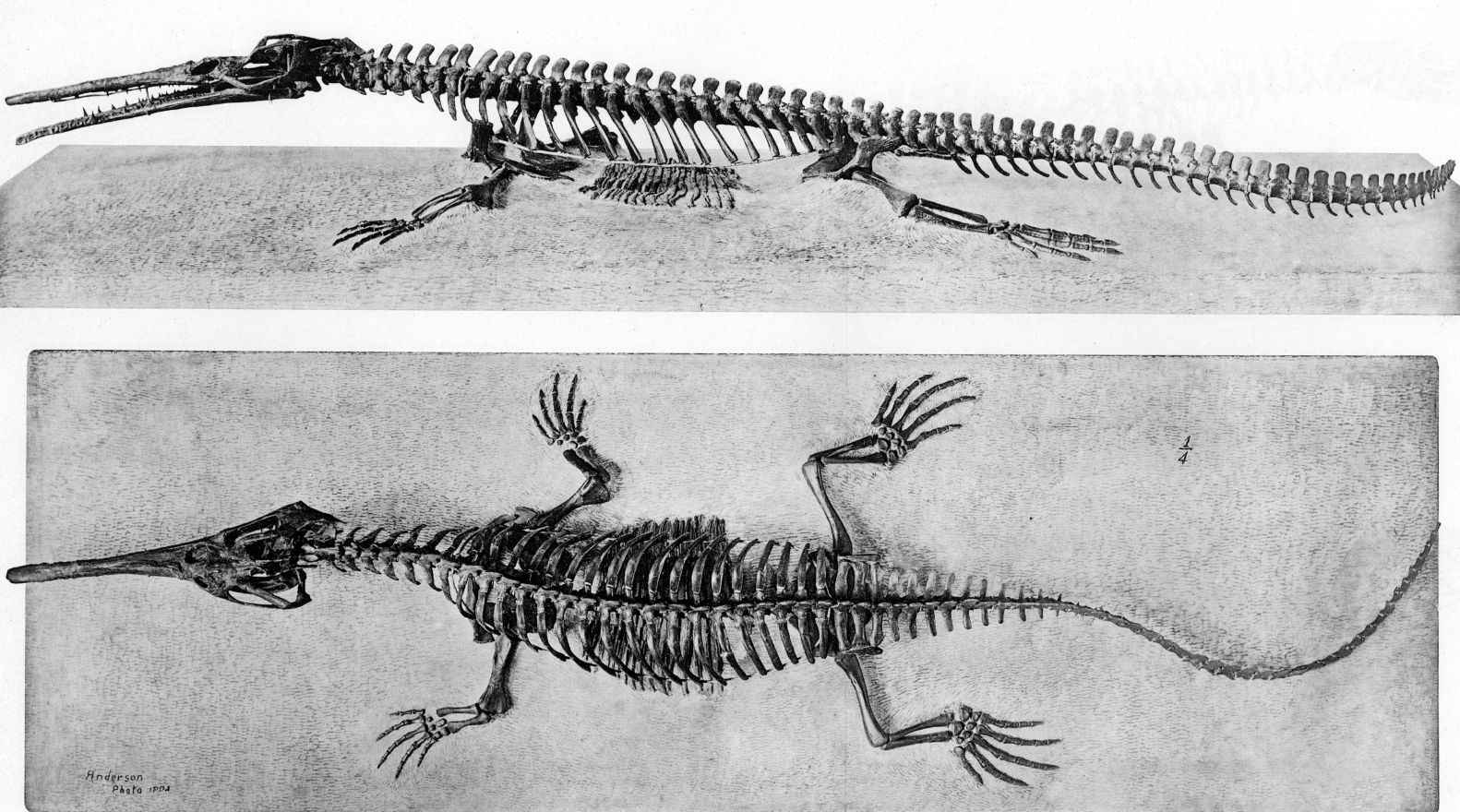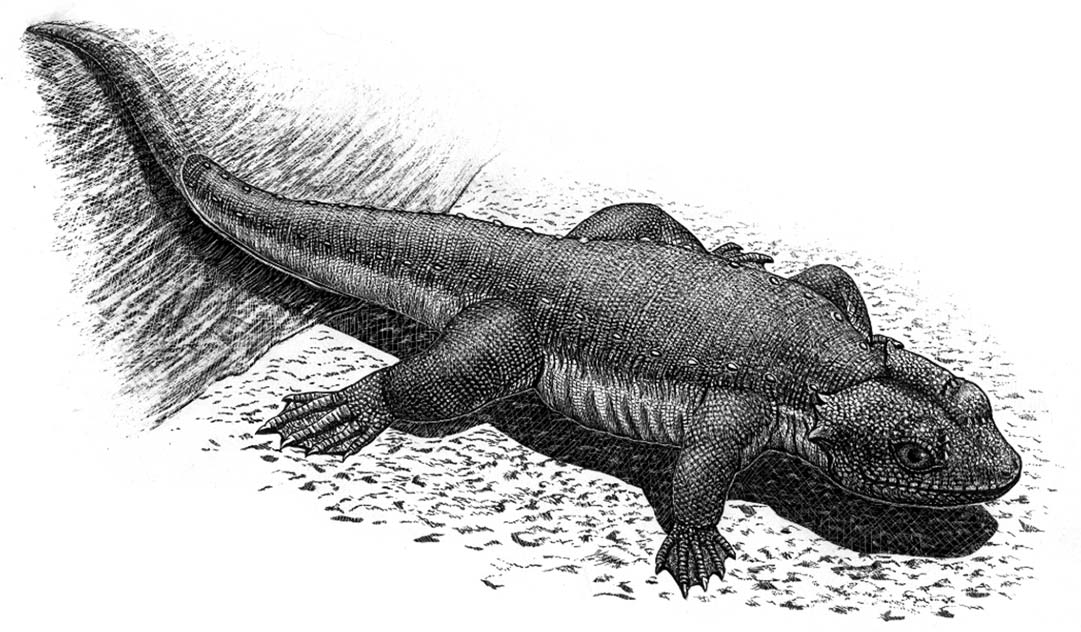|
Coeruleodraco
''Coeruleodraco'' is an extinct genus of choristoderan known from the Late Jurassic ( Oxfordian) Tiaojishan Formation in China. ''Coeruleodraco'' is significant as the most complete Jurassic choristodere taxon, as the only other named Jurassic choristodere '' Cteniogenys'' is based on fragmentary remains. Although similar to '' Philydrosaurus'' in its proportions and postcranial characters, it is distinct in retaining several apparently plesiomorphic characters, including a short snout, paired external nares and an open lower temporal fenestra. Description The skeleton was small, about 20.3 cm (8.0 inches) in length, not including the tail. The tail is incomplete, but including its estimated length, the total length of the skeleton would have been closer to 40.0 cm (15.7 inches). ''Coeruleodraco'' had a generalized, lizard-like body type. This is similar to some early choristoderes (like '' Cteniogenys'', '' Philydrosaurus'', and '' Monjurosuchus''), but contrasts with other c ... [...More Info...] [...Related Items...] OR: [Wikipedia] [Google] [Baidu] |
Choristodera
Choristodera (from the Greek χωριστός ''chōristos'' + δέρη ''dérē'', 'separated neck') is an extinct order of semiaquatic diapsid reptiles that ranged from the Middle Jurassic, or possibly Triassic, to the Miocene (168 to 20 or possibly 11.6 million years ago). Choristoderes are morphologically diverse, with the best known members being the crocodile-like neochoristoderes such as '' Champsosaurus''. Other choristoderans had lizard-like or long necked morphologies. Choristoderes appear to have been confined to the Northern Hemisphere, having been found in North America, Asia, and Europe, and possibly also North Africa. Choristoderes are generally thought to be derived neodiapsids that are close relatives or members of Sauria. History of discovery Choristodera was erected in 1876, originally as a suborder of Rhynchocephalia by Edward Drinker Cope to contain '' Champsosaurus,'' which was described from Late Cretaceous strata of Montana by Cope in the same paper ... [...More Info...] [...Related Items...] OR: [Wikipedia] [Google] [Baidu] |
Jurassic
The Jurassic ( ) is a Geological period, geologic period and System (stratigraphy), stratigraphic system that spanned from the end of the Triassic Period million years ago (Mya) to the beginning of the Cretaceous Period, approximately 143.1 Mya. The Jurassic constitutes the second and middle period of the Mesozoic, Mesozoic Era as well as the eighth period of the Phanerozoic, Phanerozoic Eon and is named after the Jura Mountains, where limestone strata from the period were first identified. The start of the Jurassic was marked by the major Triassic–Jurassic extinction event, associated with the eruption of the Central Atlantic magmatic province, Central Atlantic Magmatic Province (CAMP). The beginning of the Toarcian Age started around 183 million years ago and is marked by the Toarcian Oceanic Anoxic Event, a global episode of Anoxic event, oceanic anoxia, ocean acidification, and elevated global temperatures associated with extinctions, likely caused by the eruption of the Kar ... [...More Info...] [...Related Items...] OR: [Wikipedia] [Google] [Baidu] |
Hyphalosaurus
''Hyphalosaurus'' (meaning "submerged lizard") is a genus of freshwater aquatic reptiles, belonging to the extinct order Choristodera. They lived during the early Cretaceous period (late Barremian to early Aptian age), about 123-120 million years ago. The genus contains two species, ''H. lingyuanensis'' from the Yixian Formation and ''H. baitaigouensis'' from both the Yixian and Jiufotang Formation of Liaoning Province, China. They are among the best-known animals from the Jehol Biota, with thousands of fossil specimens representing all growth stages in scientific and private collections. Description and biology ''Hyphalosaurus'' fossils are relatively widespread in the Jehol beds, which represent a series of freshwater lakes. Several specimens of ''H. lingyuanensis'' and thousands of ''H. baitaigouensis'' specimens are known from the Yixian Formation, including entire growth series from embryos in eggs to fully grown adults. ''H. baitaigouensis'' was originally reported from t ... [...More Info...] [...Related Items...] OR: [Wikipedia] [Google] [Baidu] |
Cteniogenys
''Cteniogenys'' is a genus of choristodere, a morphologically diverse group of aquatic reptiles. It is part of the monotypic family Cteniogenidae. The type and only named species, ''C. antiquus'', was named in 1928 by Charles W. Gilmore. The holotype, VP.001088, was collected in the Morrison Formation (Como Bluff), Wyoming in 1881 by William H. Reed. More specimens have been discovered since then, including specimens from the Late Jurassic of Portugal and Middle Jurassic of Britain, which have not been assigned to species. Description ''Cteniogenys'' was long, and probably weighed less than . The skull of this genus was long and slender, and the jaws had numerous conical teeth. ''Cteniogenys'' in the Morrison probably fed on insects and small fish. It is mostly known from freshwater sites (rivers and ponds), and is a rare find in the formation (only 60 specimens out of over 2,800 total vertebrate specimens known from the formation), mostly known from northern outcrops (part ... [...More Info...] [...Related Items...] OR: [Wikipedia] [Google] [Baidu] |
Philydrosaurus
''Philydrosaurus'' is an extinct genus of choristoderan which existed in China during the Early Cretaceous. The type species ''P. proseilus'' was named in 2005. ''Philydrosaurus'' was found from the Jiufotang Formation and is slightly younger than '' Monjurosuchus'', which was found from the Yixian Formation. Description Distinct ridges cover the prefrontal and postfrontal bones of the skull, distinguishing ''Philydrosaurus'' from related genera. The lower temporal fenestra, usually present as a hole in the back of the skull of choristoderes, is closed by bone in ''Philydrosaurus''. The eye sockets are large and spaced close together, similar to ''Monjurosuchus'' and ''Lazarussuchus''. ''Philydrosaurus'' is considered more basal than these choristoderes because its eyes are not as closely spaced and face laterally rather than dorsally. The skull is similar in shape to that of ''Cteniogenys'', the most basal choristodere. The shortness of the skull and the laterally facing eye so ... [...More Info...] [...Related Items...] OR: [Wikipedia] [Google] [Baidu] |
Champsosaurus
''Champsosaurus'' is an extinct genus of crocodile-like choristodere reptile, known from the Late Cretaceous and early Paleogene periods of North America and Europe (Campanian–Paleocene). The name ''Champsosaurus'' is thought to come from , () said in an Ancient Greek source to be an Egyptian word for "crocodiles", and , () Greek for "lizard". The morphology of ''Champsosaurus'' resembles that of gharials, with a long, elongated snout. It was native to freshwater environments where it likely preyed on fish, similar to living gharials. History of research ''Champsosaurus'' was the first member of the Choristodera to be described. ''Champsosaurus'' was named by Edward Drinker Cope in 1876, from isolated vertebrae found in Late Cretaceous strata of the Judith River Formation on the banks of the Judith River in Fergus County, Montana. Cope designated ''C. annectens'' as the type species rather than the first named ''C. profundus'' due to the larger number of vertebrae he attribu ... [...More Info...] [...Related Items...] OR: [Wikipedia] [Google] [Baidu] |
Monjurosuchus
''Monjurosuchus'' is a genus of choristoderan reptile that lived in what is now China and Japan during the Early Cretaceous. It has large eyes, a rounded skull, robust legs with short claws, and a long, thin tail. Fossils have been found that preserve soft tissue, showing that it had soft skin and webbed feet. Description and history ''Monjurosuchus'' was first found in China as part of the Early Cretaceous Jehol Biota. Named in 1940, the type species ''M. splendens'' was the first reptile described from the Yixian Formation. The holotype specimen was lost during World War II but was replaced in 2000 by a recently discovered neotype preserving soft tissue. In 2007, remains were described from the Okurodani Formation of the Tetori Group of Japan. The Japanese material represents a different species of ''Monjurosuchus'' that has not yet been named. ''Monjurosuchus'' was a small choristodere, reaching a total body length of . Unlike related choristoderes, ''Monjurosuchus'' has a ... [...More Info...] [...Related Items...] OR: [Wikipedia] [Google] [Baidu] |
Postfrontal Bone
The postfrontal is a paired cranial bone found in many tetrapods. It occupies an area of the skull roof between and behind the orbits (eye sockets), lateral to the frontal and parietal bones, and anterior to the postorbital bone. The postfrontal forms part of the rear and upper border of the eye socket when present. It is particularly large in many extinct amphibians and their sarcopterygian (lobe-finned fish) ancestors, stretching forwards to contact the prefrontal, thus separating the frontal from the rim of the orbit. In living amphibians ( lissamphibians), the postfrontal is absent, having failed to ossify during development. The postfrontal is present but reduced in some reptiles, including modern squamates (lizards and snakes). It is lost or fused to surrounding bones in mammals, crocodylomorphs (including crocodilians) and dinosaurs (including birds), though it is present in other extinct archosaurs Archosauria () or archosaurs () is a clade of diapsid sauropsid tetrapo ... [...More Info...] [...Related Items...] OR: [Wikipedia] [Google] [Baidu] |
Diapsid
Diapsids ("two arches") are a clade of sauropsids, distinguished from more primitive eureptiles by the presence of two holes, known as temporal fenestrae, in each side of their skulls. The earliest traditionally identified diapsids, the araeoscelidians, appeared about three hundred million years ago during the late Carboniferous period. All diapsids other than the most primitive ones in the clade Araeoscelidia are often placed into the clade Neodiapsida. The diapsids are extremely diverse, and include birds and all modern reptile groups, including turtles, which were historically thought to lie outside the group. All modern reptiles and birds are placed within the neodiapsid subclade Sauria. Although some diapsids have lost either one hole (lizards), or both holes (snakes and turtles), or have a heavily restructured skull (modern birds), they are still classified as diapsids based on their ancestry. At least 17,084 species of diapsid animals are extant: 9,159 birds, and 7,925 s ... [...More Info...] [...Related Items...] OR: [Wikipedia] [Google] [Baidu] |
Squamosal Bone
The squamosal is a skull bone found in most reptiles, amphibians, and birds. In fishes, it is also called the pterotic bone. In most tetrapods, the squamosal and quadratojugal bones form the cheek series of the skull. The bone forms an ancestral component of the dermal roof and is typically thin compared to other skull bones. The squamosal bone lies ventral to the temporal series and otic notch, and is bordered anteriorly by the postorbital. Posteriorly, the squamosal articulates with the quadrate and pterygoid bones. The squamosal is bordered anteroventrally by the jugal and ventrally by the quadratojugal. Function in reptiles In reptiles, the quadrate and articular bones of the skull articulate to form the jaw joint. The squamosal bone lies anterior to the quadrate bone. Anatomy in synapsids Non-mammalian synapsids In non-mammalian synapsids, the jaw is composed of four bony elements and referred to as a quadro-articular jaw because the joint is between the art ... [...More Info...] [...Related Items...] OR: [Wikipedia] [Google] [Baidu] |





